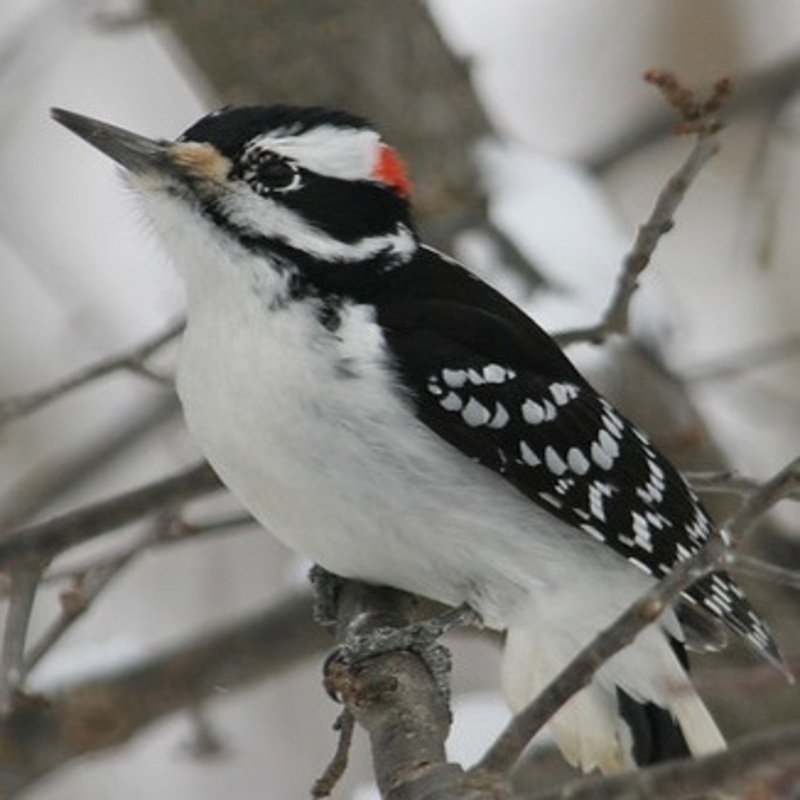Dryobates villosus, commonly known as hairy woodpecker is a medium-sized woodpecker that is found throughout North America. According to the IUCN, the hairy woodpecker has a population of over nine million individuals in 2003. Some ornithologists classify it as Dryobates.
The Hairy Woodpecker is similar to the Downy woodpecker, but larger (634 versus 914) and with a larger bill. Both have black spots or bars on the outside of their outer tail feathers. This species also belongs to the family of Picidae.
Quick Overview: Dryobates Villosus – Hairy Woodpecker
Body size: Around 8.5-10.5 in (22-27 cm) and weight of 71 g (2.5 oz)
Main colors: Black, White, Orange-red,Brown
Range: Throughout United States
Migratory Bird: Yes
Best time of the year to see in the U.S.: All Year (January – December)
Conservation Status: Least Concern
Dryobates villosus Description
Adults are mostly black, with a white or pale back and white spotting on the wings; the throat and belly vary in color from white to sooty brown depending on subspecies. A white bar is above and below the eye. White outer feathers on a black tail adult males have a red patch on the back of their heads, while juvenile males have a red or orange-red crown.

Size
These birds have a length of 8.5-10.5 in (22-27 cm) and a weight of 71 g (2.5 oz). Their wings could range from 15-17.5 in (38-44 cm).
Feeding
Insects, particularly gypsy moth caterpillars and pupae, spiders, nuts, seeds, and fruits are included in the diet, and the animal forages in trees, bushes, brush piles, and canes.
Habitat
Deciduous forests are among the species’ preferred habitats.
Behavior
These birds forage for insects on trees, frequently turning over bark or excavating to uncover the insects they are looking for. They primarily consume insects, but they also consume fruits, berries, and nuts, as well as tree sap on occasion. They are a natural predator of the European corn borer.
Leuconotopicus villosus Scientific Classification
- Kingdom: Animalia
- Phylum: Chio
- Subphylum: Chelicerata
- Class: Aves
- Order: Piciformes
- Family: Picidae
- Genus: Leuconotopicus
- Species: Leuconotopicus villosus
Subspecies
There are 17 subspecies recognized species.
Best time of the year to see
In the United States, the best time of year to see these birds is all year round, regardless of the season. This refers to any month of the year between January and December
Distribution of the Hairy woodpecker in the USA
This bird, which is native to North and Central America, prefers to live in subtropical or tropical forest ecosystems. There are mature deciduous forests where the hairy woodpecker can be found in the following countries: the Bahamas; Canada, Mexico, Nicaragua, Panama, Saint Pierre, Miquelon, and throughout the United States.
The Hairy woodpecker can be found in the following states in the United States – Alabama, Alaska, Arizona, Arkansas, California, Colorado, Connecticut, Delaware, Florida, Georgia, Hawaii, Idaho, Illinois, Indiana, Iowa, Kansas, Kentucky, Louisiana, Maine, Maryland, Massachusetts, Michigan, Minnesota, Mississippi, Missouri, Montana, Nebraska, Nevada, New Hampshire, New Jersey, New Mexico, New York, North Carolina, North Dakota, Ohio, Oklahoma, Oregon, Pennsylvania, Rhode Island, South Carolina, South Dakota, Tennessee, Texas, Utah, Vermont, Virginia, Washington, West Virginia, Wisconsin, and Wyoming.
